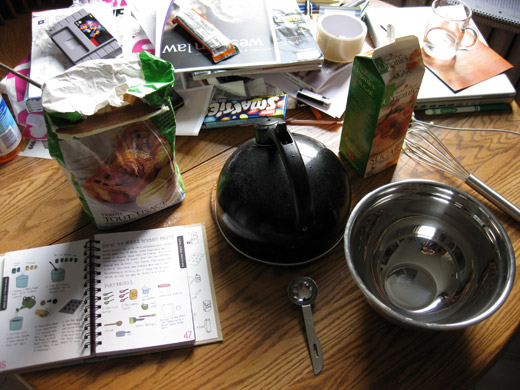
Danielle and I spent the better part of the afternoon a couple days ago going through wheatpaste recipes, ultimately going with the simplest. We had wanted to avoid having to use a hot plate to make it, and after 4 different recipes requiring varying amounts of heat, we were successful.

Flour.

Flour + cold water.

Whisking the mix and adding hot water.

Danielle takes over whisking, this first mix was too watery.

This was the first couple of test papers.

This was another recipe, heated on the stove, testing it on my desk.

In our search for tools with which we can apply the wheat paste, I also wondered if we could make our own. This would involve a water bottle, sponge, and small tube in the middle of the sponge.

Danielle uses her hot glue skills.

It was a delicate procedure, as everything is when it comes to hot glue.

The final recipe, the one that works, simply hot water and then flour until it’s a good consistency… that good consistency is somewhere like a smoothie…

This is the second version of the wheat paste applicator, the problem with this particular bottle was that the cap was squishing the sponge too much.

More test papers on my desk… the latest recipe worked best.

A couple more test papers.

Test 1 outside.

Test 2 outside.
We’ll demo the recipe and the applicator on Thursday.

Would you be willing to write up a quick summary of the recipe that you decided on. Nothing special, just the outline with a little more detail. i.e. Some measurements if you have them, and heating-time if you use it. Thanks a lot.
James
hi James,
Here’s the recipe, as I remember it (with some more specifics)…
-bring 2 cups of water to a boil
-pour boiling water into a mixing bowl
-slowly add white flour, 1 tablespoon at a time, mixing continually, until the consistency is close to that of a smoothie
Of course, you can adjust as need be, but the key is to add the flour slowly, and a little bit at a time, so you have better control of the consistency.
How do you reuse wheat paste after you refrigerate it, right now i have a solid lump of the stuff i tried adding water and nukin it in a microwave neither worked, did I just make a bad batch or is there another way
Eh, mine kind of tends to do that too, but the paste still seems to work allright. I usually try and mix a litttttle bit of warm water with it and then just spread it onto the wall or paper in big globs. The stuff that I pasted back in February that wasn’t removed is still up. Give it a shot and tell me what you think.
I haven’t even tried refrigerating wheat paste, because from what I read when researching it, the paste won’t keep for long. However, if you only refrigerated it overnight, it should still be fine… Usually, I’ve just made small batches, but I’ve kept some for a few days in the fridge.
James, when you pasted with refrigerated paste + warm water – is the stuff that has been up since February?
Yeah, I used the refrigerated stuff for the paste-ups done in february. But I had used it before that around a year ago for another paste-up that is completely faded, but still up.